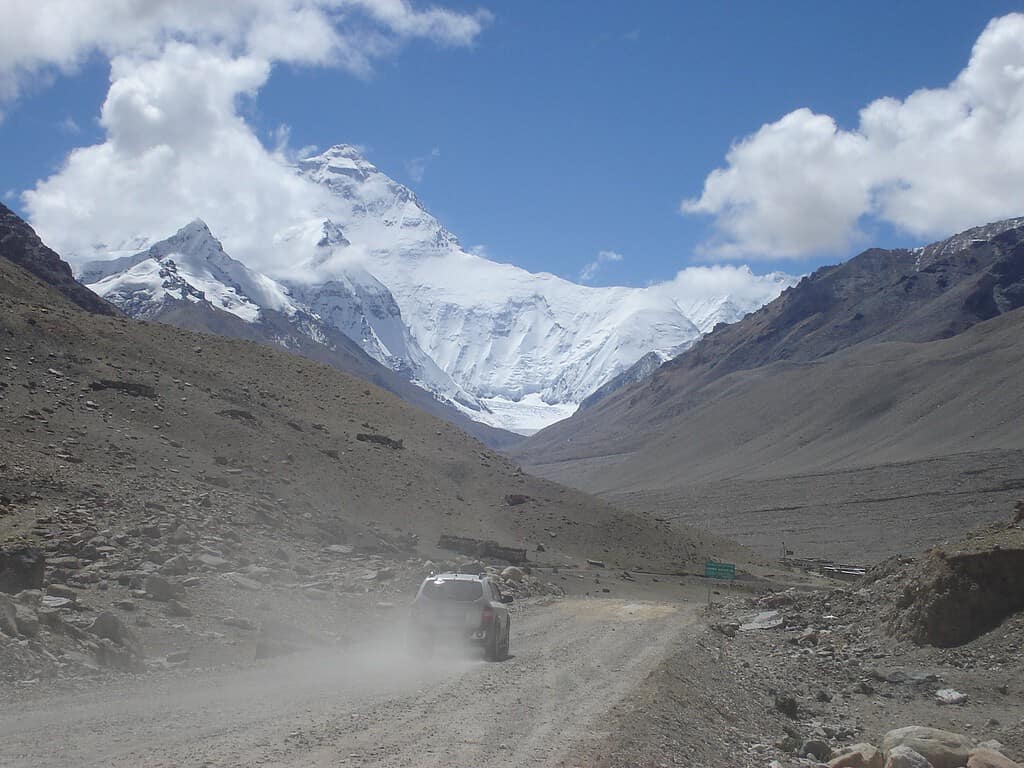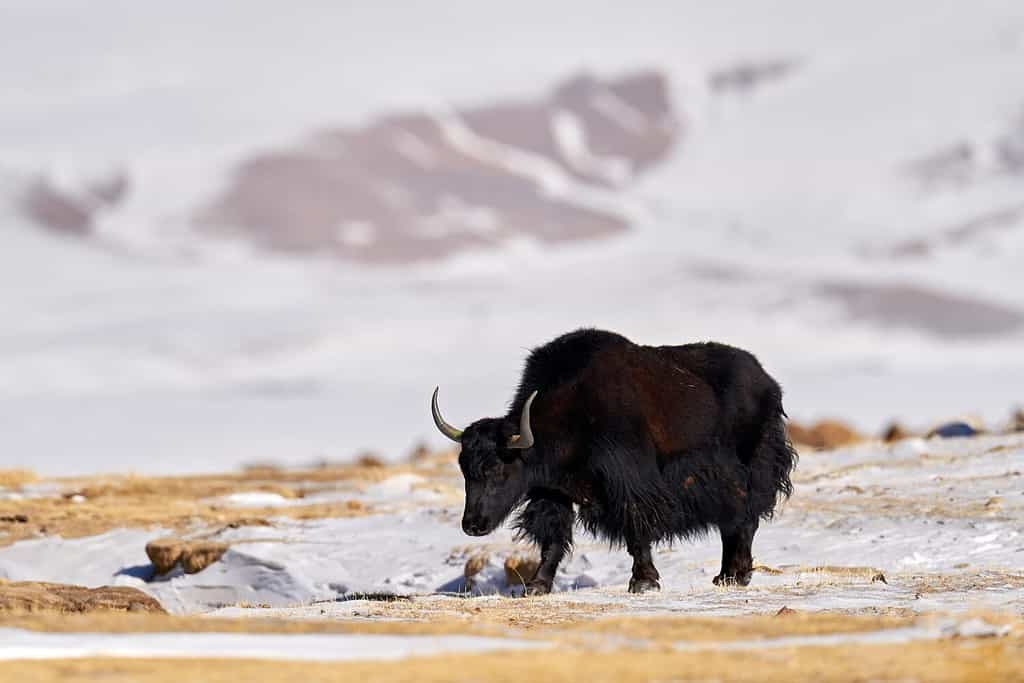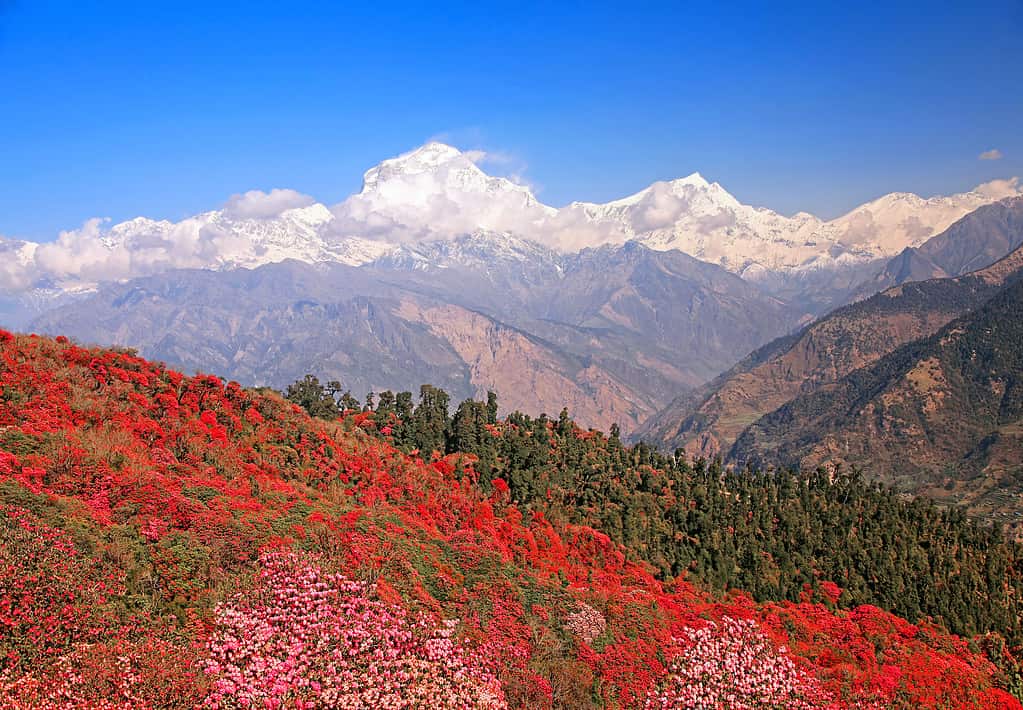Most folks know Mount Everest is the tallest mountain on land, but its location is another matter! So, where is Mount Everest exactly, what country is it in, and what’s located in the surrounding areas?
Let’s discover Mount Everest’s location.

Mount Everest is located in the
Himalayan
Mountain range between Nepal and Tibet.
©Gail Morrison / CC BY-SA 3.0 – License
Where Is Mount Everest Located?
Mount Everest is located in the Himalayan Mountain range in an autonomous region of China between Nepal and Tibet. Its exact spot is in Sagarmatha National Park, but the peak is co-shared between Nepal and Tibet.
Sagarmatha National Park is located in the eastern part of Nepal. It’s 443 square miles (1,148 square km) of rugged landscape. More on this incredible national park later.
How Tall Is It?
Mount Everest is known as the highest mountain in the world. Its 29,029-foot altitude is comparable to a jumbo jet’s cruising height, but it’s not actually the tallest mountain on Earth. That honor goes to the colossal inactive Hawaiian volcano Mauna Kea. This epic peak reaches 33,803 feet tall. However, because most of Mauna Kea sits below sea level, Mount Everest is the highest mountain on the planet, above sea level.
The Surrounding Area
Mount Everest sits in Sagarmatha National Park, in the Himalayan Mountain range. Here are some incredible facts about this wild, remote area.
Sagarmatha National Park
Established as a National Park in 1976, Nepal’s 443 square mile Sagarmatha National Park ranges from 9,334 to 29,029 feet at Mount Everest’s summit. The park is almost 70% barren land. Due to its high altitude and fierce weather, few plants and animals manage to make a life there. Minimally grassed areas grazed by yaks form another 27%. Only 3% of the landscape is forested.
In these forested areas, firs, blue pines, bamboo, birch, juniper, and rhododendrons dominate alongside mosses and lichens. All of this ecosystem thrives in the lower boundaries.
Sagarmatha National Park hosts vigorous treks and guided tours at high altitudes. It’s a challenging landscape that’s only suitable for fit and experienced hikers who’ve acclimatized to its lower oxygen levels.

Yaks graze in Mount Everest’s shadow.
©Ondrej Prosicky/Shutterstock.com
The Himalayas
The colossal Himalayan Mountain Range spans five Asian countries. India, China, Pakistan, Bhutan, and Nepal. In Sanskrit, Himalaya means “snow abode.” The mountains get this name because permanent snow tops the loftiest peaks.
The Himalayan Mountains formed when two tectonic plates (Indian and Eurasian plates) collided around 50-60 million years ago. Even today, the Himalayas grow 44 millimeters each year.
Mount Everest’s neighbors include:
- Lhotse Peak, 27,940 feet (8,516 meters), the fourth-highest peak in the world
- Nuptse Peak 25,791 feet (7,861 meters)
- Changtse Peak 24,803 feet (7,560 meters)
- Khumbutse Peak 21,867 feet (6,665 meters)

Rhododendrons bloom in the Himalayan Mountain range below Mount Everest
©Kiwisoul/Shutterstock.com
People
Around 40 million people live in the Himalayan region, such as the Sherpas of Nepal, who are famed for their incredible endurance. Sherpas frequently carry support supplies to Mount Everest’s peak.
Sherpa means “people from the East” because they’re native to Eastern Tibet. Sources suggest they settled in the Mount Everest region in the 16th century. Because they’re relatively cut off from the rest of the world, including their closest neighbors, sherpa culture has evolved distinct differences. These differences attract tourism, which supports sherpas alongside their traditional subsistence farming and trade.
Climate
Mount Everest experiences year-round cold weather, very heavy snowfall, and freezing winds. It sits in the highland alpine climate zone. Its January temperature is minus 33 degrees F, but it can fall to minus 76 degrees Fahrenheit. When the ferocious winds die down in May, intrepid folks attempt the climb. At this point, the temperature is around minus 2 degrees Fahrenheit.
Animals
Strong winds, freezing temperatures, and lack of oxygen create a hostile environment on Mount Everest. No plant life or animals live there. However, the surrounding Sagarmatha National Park hosts 118 bird species and an array of unusual mammals.
Asiatic Black Bear
Also called the moon bear, medium-sized Asiatic black bears reach 6.5 feet long. Their dense fur ranges from dark brown to black with a white moon-shaped chest patch, hence the name moon bear.
They spend half their time in treetops and feast on insects, fruits, and nuts. Solitary Asiatic black bears only meet to mate in spring, and they hibernate from November until April.
Snow Leopard
Elusive snow leopards live at 3,000-5,000 feet altitude in the Eastern Himalayas. The IUCN lists snow leopards as vulnerable due to only 2,710-3,386 individuals remaining in the wild.
Snow leopard fur grows extra-thick during the winter, and huge paws act like snowshoes to prevent sinking into the snow. Adults reach 26 inches tall and 44 inches long, plus an extra long 40-inch tail for balance. Snow leopards also use their tails to protect their noses from the biting cold. Their main prey include mammals such as red pandas, thar, or marten.

Elusive snow leopards hunt red pandas, martens, and thars.
©Chris Desborough/Shutterstock.com
Red Panda
Cat-sized, bamboo-munching red pandas live in the eastern Himalayan Mountain range. They don’t much resemble the black and white pandas we know well. Rather, they’re browny-red with a white facial mask and a fluffy, stripy tail. Red pandas chiefly live in the trees, sleeping with their long tails wrapped around their body like duvets.
Himalayan Wolves
In the safety of the Himalayan mountains, these wolves don’t face shooting or human persecution like America’s wolves; hunting them is banned here. They look pretty similar to gray wolves with thick, woolly grey fur and a yellow-toned face.
These wolves impressively cope with thinner air in the mountains, hunting sheep, thar, and other mammals as a pack.

It’s illegal to hunt or capture Himalayan wolves.
©Ativ Srivastava/Shutterstock.com
Himalayan Thar
The Himalayan thar is a goat-like animal with a super thick coat, 18-inch long backward curled horns, and incredible jumping abilities. These ungulates can climb almost vertical cliffs. Thars graze on vegetation and avoid the deathly clutch of snow leopards.
The Yeti
Ape-like mythological (or is it) Yeti inhabits the Himalayan Mountain range. In the Western world, Yeti is hilariously called the Abominable Snowman! Few people have spotted the creature, and some experts think it’s a moon bear on hind legs rather than a massive ape-human. Either way, rumors purport it lives near Mount Everest.
Brief History of Mount Everest
Wondering how Mount Everest got its name?
Well, in 1865, it was named for George Everest, a former surveyor of India. Before this, the Western world called it simply Peak 15, but the tallest land mountain on Earth has older names.
- Sagarmatha by the Nepalese, which means Goddess of the Sky
- Chomolungma by the Tibetans, which means Goddess Mother of Mountains
The mountain is a sacred place for Tibetans and Nepalese. Before mountaineers attempt the summit, they’re required to ask permission and safe passage in a Puja ceremony.
Coming back to George Everest, because his name is pronounced Eve-rest, not Ever-rest, the mountain’s western name is nearly always pronounced incorrectly.

Mount Everest was named after the British surveyor George Everest in 1865.
©bodrumsurf/Shutterstock.com
Who Climbed It First?
On May 29, 1953, Sir Edmund Hillary and Tenzing Norgay, a sherpa who helped him, became the first people to reach Mount Everest’s summit.
Since then, over 6,000 people have ascended the peak. Over 1,000 of them are sherpas who have climbed up numerous times.
However, Mount Everest is a deadly place. It’s said to be a place where it’s expected to encounter human remains. 300 people have lost their lives on this treacherous route, and around 200 of those fatalities are still on the mountain. Because it’s such a difficult place to traverse, retrieving bodies is not the norm. People have died trying to recover remains.
George Mallory died attempting the climb in 1924, and he was the oldest known body on Mount Everest. In 1999 his body was found there with broken bones. He wasn’t moved.
Can I Visit Mount Everest Without Climbing?
Yes, Mount Everest isn’t all about trying to reach the summit. Tourists can enjoy the surrounding areas and the hospitality of the country.
Towns, monasteries, and helicopter tours in the areas rely on tourists for their livelihoods but don’t expect a standard helicopter ride over the peak. The air is way too thin to achieve enough lift. Only high-altitude helicopters can make it; even then, it’s not 100% certain it’ll make it.
Where Is Mount Everest?
So, we’ve learned that Mount Everest is located in the Himalayan Mountain range between Nepal and Tibet, in an autonomous region of China. The surrounding area is rugged, cold, and extreme to say the least, but distinctive humans and animals have made it their home.

Mount Everest is located in Asia’s Himalayan Mountains.
©Martin Gillespie/Shutterstock.com
The photo featured at the top of this post is © Vixit/Shutterstock.com
Thank you for reading! Have some feedback for us? Contact the AZ Animals editorial team.






